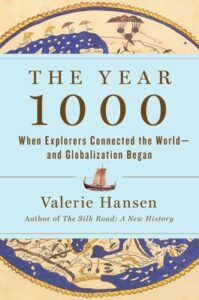The Year 1000: When Explorers Connected the World – and Globalisation Began
by Valerie Hansen (Viking / Penguin, £20.00 / €23.50)
Having been reared on the idea, common enough in the 19th century and later, that the year 1000 was rife with fears of an imminent Day of Judgement, I was a little surprised to read in Dr Hansen’s book that “Few Christians believed that Christ would return to Earth in the year 1000. Various itinerant preachers and Church reformers claimed to be the messiah and led uprisings, but their movements occurred in different centuries, none near the year 1000. “

One has to wonder then how the new Norman sovereigns of Britain came to call the great survey of the newly seized kingdom the Doomsday book? Readers of Norman Cohn’s The Pursuit of the Millennium may also be surprised by Hansen’s mild account of a Europe already filled with social and religious turmoil.
But then that is what may happen when you look too closely at just one region such as Europe. Dr Hansen creates a happier view by going global. But was 1000 a crucial date?
The other week I was reading Thor Heyerdahl’s The Maldive Mystery, which suggests that globalisation had been active half a millennium earlier, and even before that.
Maldives
He relates that an important export of the Maldives in ancient times were cowrie shells, found only in the islands and used there as money. These shells have been unearthed in pre-Viking tombs (AD 550-800) in Sweden, and also in Finland.
They had been passed hand to hand across many thousands of miles from their source. Certainly there was a connection between Finland and the Maldives; but mere connection of this hand to hand kind does not imply real communication.
Note that the book claims to speak about “explorers”, but in fact the real heroes of this book are not explorers in the ordinary sense, but traders, those innumerable unnamed persons that pass almost unnoticed by historians.
Dr Hansen’s basic idea is that the year 1000, far from being a year of fear, was a year of active achievement. For the first time, she claims, it was possible to pass commercial items around the globe.
This, however, is an exaggeration. There were, for instance trading connections between Mexico and Peru, but these did not connect with the Vikings in Greenland and Canada, as she implies. The Vikings traded in furs, salted cod, and marine ivory from walruses and narwhales. They did not connect with the Aztecs or the Incas or know of their realms of gold.
Though there is much to disagree with in this book, there is also much that is of great interest, which makes it well worth reading to extend one’s ideas of the medieval world”
Indeed, the Viking did not see themselves as being in “a new world” (as Columbus later did), but as settlers in a little known extension of northern Europe. In this sense they did not “discover America” at all. Their little colony was known to the Vatican as a part of Christian Europe: all very unglobal.
But though there is much to disagree with in this book, there is also much that is of great interest, which makes it well worth reading to extend one’s ideas of the medieval world.
In her chapter on Russia, for instance. we learn that the word ‘slave’ in English and ancient Greek comes from the word Slav, an inhabitant of what we now generally call ‘Russia’.
She describes how at this time Vladimir Prince of Kiev made a cost / benefit decision about what religion he and his people would follow, rejecting Catholicism for an unstated reason in favour of Orthodoxy because it was the more powerful. Dr Hansen sees religion not as a matter of spiritual integrity at all, but purely as a transactional affair.
Africa
The most interesting chapter deals with Africa, which introduces the reader to the Mansa Musa, King of Mali, “the world richest man”, who brought so much gold with him on a visit to Cairo – several tons of it – that he upset the local economy.
Like many American writers she wishes to give a positive version of African history, even when this means playing down the matter of African participation in the slave trade from the earliest days, and accepting the Arab penetration of Africa as natural and proper compared with later European colonisation. Non-Islamic Africa has little presence for her. She is fascinated by King Mansa’s gold, rather than the knowledge of Africa as the earliest home of humanity, from which the whole global community emerged.
When she speaks of globalisation in 1000 she fails to emphasise that it was a matter of luxuries, gold, silver, gems, and spices, for the high status classes of Europe and China.
Globalisation
It did not involve what globalisation does today, the using of Africa, where millions starve, to raise vegetables for your kitchen. Her final chapter deals with “the most Globalised place on earth”, that is to say China – neatly fitting in with American›s present day perceptions.
Having berated the Vikings for killing the first Native Americans they came upon, Hansen notes that on other continents, those who encountered strangers took their time, greeted them patiently, and traded their belongings for whatever goods their new acquaintances offered (though this often meant diamonds for glass beads). Some of the most successful learned languages and forged trading relationship across huge distances.
“True globalisation didn’t benefit everyone who experienced it,” Hansen concludes. “But those who remained open to the unfamiliar did much better than those who rejected anything new. That was true in the year 1000, and it’s just as true today”.
Nor does she allow much for the sheer greed and cruelty of the powerful in relation to the weak. Commerce is not everything; communication is”
These charmingly optimistic words read strangely when there are riots in these islands to reject aliens, and in her native United States candidate Trump is proposing to deport millions from the country.
The Year 1000 in an enjoyable, if at times, irritating read. The author seems to little understand the social and mental role that religion plays in making the world. Nor does she allow much for the sheer greed and cruelty of the powerful in relation to the weak. Commerce is not everything; communication is.
I think anyone reading her book would benefit also from reading John Man’s Atlas of the Year 1000 (Penguin Books), which gives in a form which tries less to be a popular read, in which the nature of the cultures and civilisations, especially in Asia and Africa involved in the period are described in a set of finely crafted and explicated maps. Indeed he gives an equally informative account of world connections over the long course of history.


 Peter Costello
Peter Costello The “richest man in the world”, King Mansa Musa of Mali
The “richest man in the world”, King Mansa Musa of Mali 